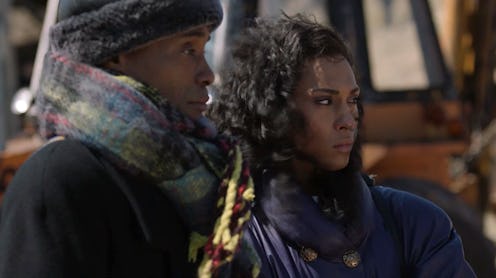Entertainment
Blanca & Pray Tell's Trip To Hart Island On 'Pose' Sets The Tone For Season 2

Spoilers ahead for the Pose Season 2 premiere. In the first season of Pose, Blanca and Pray Tell both learned they were HIV-positive in 1987 New York City. Now in Season 2, it's 1990 and Pray Tell (Billy Porter) and Blanca (MJ Rodriguez) travel to Hart Island on Pose. They are there to visit the grave of Pray Tell's ex who died from complications of AIDS. But Hart Island isn't exactly a cemetery — it's a mass grave site in what Pray Tell calls "the most remote part of New York." Kicking off the new season on the real-life Hart Island shows that outside the fashion and fun of the balls, the community was suffering from the HIV/AIDS crisis. And this location is a grim reminder that the world wasn't kind to people who died of HIV/AIDS, even after they passed.
While Blanca had a lot of ups in Pose Season 1 with the creation of her own House and being awarded Mother of the Year, she still is living with her HIV diagnosis. And as Sandra Bernhard's Nurse Judy informs her in the Season 2 premiere, "Acting Up," Blanca's HIV has now become AIDS. Blanca isn't aware of this fatal change in her diagnosis when she visits Hart Island with Pray Tell. But she sees firsthand how some people who died of HIV/AIDS are indifferently buried in this potter's field of New York City.
As The New York Times reported, Hart Island is a real potter's field located on an inhabited island off the coast of the Bronx. New York City purchased the land back in 1868 to bury people who had no living relatives to take care of their bodies, were left unclaimed at the morgue, or were too poor to afford a burial. More than a million bodies are buried on Hart Island with the corpses placed in pine boxes and mass buried in trenches.
The city employee who "greets" Blanca and Pray Tell to Hart Island brusquely explains all this to them in the opening scenes of Pose Season 2. It's also historically accurate when Pray Tell says that Nurse Judy told him the island used to be a tuberculosis ward. The New York Times reported that before becoming a grave site, Hart Island was also home to a tuberculosis hospital, a "lunatic asylum," a boys' reformatory school, and a prison for Confederate soldiers. But for the last 150 years, it has been a bleak end for many people, including immigrants, the homeless population, and people who died of HIV/AIDS.
NPR's Here & Now highlighted how people who had died of HIV/AIDS and were buried on Harts Island during the height of the epidemic were put in segregated graves so as not to contaminate the other bodies. The Hart Island Project was established by Melinda Hunt to help locate people's bodies who were buried there from 1980 and after. The project has an AIDS Initiative that identifies people with AIDS who were buried there, including the 17 AIDS patients who were buried in individual graves due to their diagnosis.
The New York Times reported in 2018 that once it was known that the corpses were not contagious, people who had HIV/AIDS were buried in the mass graves with everyone else. But in the early days, fear took over. "Part of the history of the AIDS epidemic is buried on Hart Island, and it's the unknown part," Hunt told The New York Times. The publication also highlighted that heart-shaped stones have been left as markers on the island, just as Pose shows.
You can do a virtual tour of Hart Island on The Hart Island Project website. It allows you to read the stories of people who are buried in specific plots and indicates plots that contain the bodies of people who had AIDS. Hunt told NPR's All Things Considered that one of the reasons she created this interactive map is because of the limited access to Hart Island. She advocates for the city to make it more accessible to families and loved ones of the deceased to visit.
If you wanted to visit the island yourself, the New York City Department of Corrections runs the mass burial site. They have created their own database since 1977 of people who are buried there and there are two ways to visit. You can either join the monthly trips, which happen on the third Thursday of each month. Or family members can request a gravesite visit, which also only occurs once a month on a weekday.
As Hunt tweeted in June 2019, better access to Hart Island is a topic that is being discussed by politicians. And while Pose can't change the past, it's helping honor these lost souls by exposing the truth about the unmarked graves and telling the stories of characters who are living with HIV/AIDS in 1990 New York City.